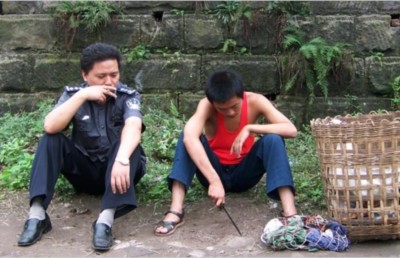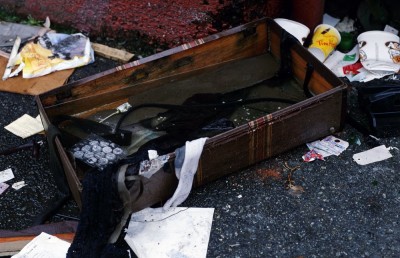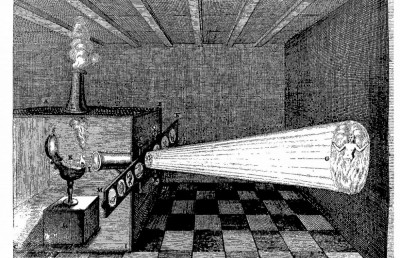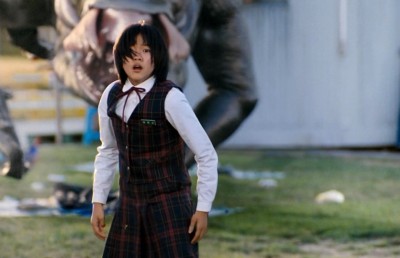Manufactured Landscapes
The Global Insectarium
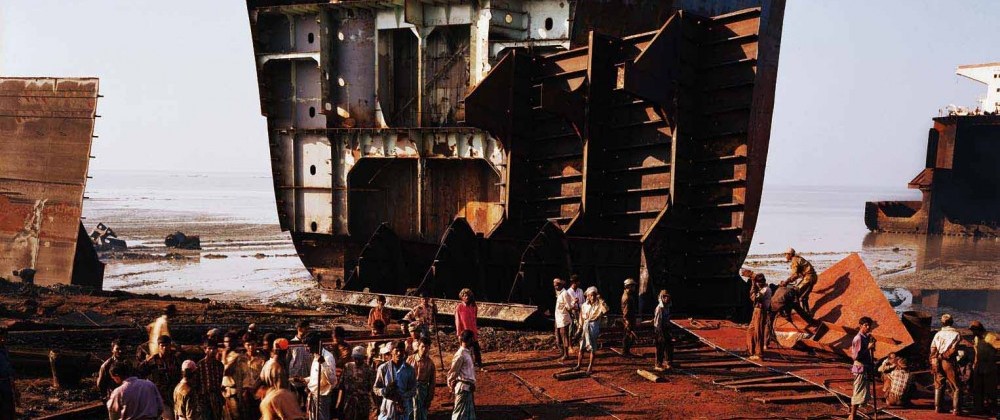
Manufactured Landscapes
Jennifer Baichwal, 2006, Canada, 90 mins.
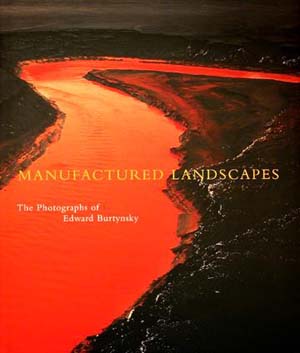
Oftentimes one can tell whether a film is “really worth” watching by the time the first shot and the first cut are done. And with Manufactured Landscapes you can just tell that something’s up from the first shot: an uninterrupted 9 minute plus dolly of assembly line workers at their posts, going about their business, in a giant industrial facility in China. 1 It’s the kind of shot that can stand on its own as a small film and it’s the kind of touch that Jennifer Baichwal, the director of this documentary, adds throughout the film to make it more than a profile film about a photographer and his work. Everyone, of course, clusters to the name and work of Edward Burtynsky—the photographer on whose persona and fabulous work the film dotes upon—but Baichwal has more to say than what meets the photographer’s eye. She contextualizes Burtynsky’s work in such a way that the photographs almost become illustrations of her take on the settings portrayed in the photographs.
The first shot does a variety of things very economically: it sets up the thématique of transformation right form the start—we see industrial workers on a variety of assembly lines transforming components from around the world into processed manufactured goods that will in turn be distributed and sold throughout the globe; it leaves the viewer to take in the enormity of the Chinese industrial endeavor; and serves as the first installment in another kind of transformation: the metamorphosis of industrial workers into insects as a result of Globalization.
Manufactured Landscapes feels like it could almost be the companion video to David Suzuki’s book From Naked Ape to Superspecies in which Suzuki describes the ability of humans to alter on a large scale the physical geography and ecology of our planet. At first glance, the book’s title reads like a paean to the idea of “progress as advancement” as implicit in most Westerners’ conception of history and Manufactured Landscapes’ success lays in turning that paradigm on its head—but only if you choose to look at it that way. To me, the film demonstrates how the superspecies’ unbridled exploitation of natural resources and economic predation by over-achieving, egotistic, egoistic omnivores is proving catastrophic to the planet. But, and it’s a big but, the apolitical tone of the photography could also allow viewing it “sans-engagement” just for the Wow! value of the imagery.
The film brings up disquieting issues about the aesthetics of political commitment and involvement and the ethics of art and representation. I can appreciate Burtynsky’s images of quarries and mines as metaphors for aesthetic exploration, desolate landscapes of mine tailings standing for existentialist alienation, etc. but it’s kinda late in the day for such a distanced approach to what’s being done to the planet. Burtynsky’s photographs are decidedly non-committal—taken at face value, the work purports to be objective, neutral, dispassionate—a testament to Burtynsky’s ability to render plastically beautiful anything that passes before his lens. Still, there’s a duplicity to the approach which possibly represents the price to pay when working with the devil. There is a scene in the film shot in Tianjin’s Tanggu Port where as far as the eye can see, receding into the horizon, mounds of coal cover the landscape. The film and photography crew is on location without proper clearance and it is intercepted by Chinese authorities. They try to convince the authorities to allow both shoots to go on even though the mounds of coal are an environmental p.r. disaster for the Chinese—don’t worry, the crew says, the “photographer’s eye” will make everything look beautiful! To illustrate they pull out a book of Burtynsky’s photographs of open-pit mines, quarries, and unchecked effluent from mine tailings in the U.S. and Canada depicting environmental decimation, rendered aesthetic and innocuous! Perhaps this is the reason Burtynsky’s photographs are found in the collections of many of Canada’s largest corporate and financial entities 2 —by aesthetizing the imagery does one also anaesthetize it? Does purchasing the photographs assuage corporate guilt of their Faustian endeavor? 3 Can you buy in to opt out? Are Burtynsky’s photographs self-reflexive Faustianism? Had Burtynsky been a photographer during WWII would he have photographed the death camps as odes to the Nazi’s ability to streamline the killing of Jews?
Baichwal’s documentary imagery would lead us to believe that the concerns lay elsewhere. The film follows Burtynsky to show us what lies outside the photographer’s frame at the hot spots of globalization. Although Manufactured Landscapes is primarily about the effects of unbridled industrialization on the Chinese landscape, we are shown how the industrialization is transforming the physical landscape in key areas touched by globalization. The film presents processes of extraction, transformation, usage, disposal and reuse as a series of enmeshed cogs that keep each other turning much like the interconnected air currents of global weather patterns.
These processes are each presented at a macro-scale, not at the undifferentiated statistical scale of economics, but a scale where humans are not the masters of their environments, a scale where an entity larger than human calls the shots. It’s a scale that Westerners have been loathe to assume—our anthropocentric egotism has entitled us to assume the role of the observers and not as subjects of observation. Manufactured Landscapesupholds this tenuous vantage point by turning our gaze towards “the other” because as Westerners, we still hold on to the point of view of the colonizer; we adopt the role of observer and cast ourselves as the objective reality to Chinese or Bangladeshi subjects. When the lens does turn its gaze upon the West, we see photographs of misdeeds that are “behind us” as in the uncontextualized images of mines, oil-drilling fields, or mine tailings or in footage casting us as consumers of manufactured products with an insatiable appetite for oil and its byproducts.
Baichwal makes the connection of oil as the key building block of the economics of the last century: for the West, it’s an oil-dependent lifestyle of cars and asphalt, rubber tires and superhighways, plastics and pollution—life as a symphony of petroleum derivatives where cloverleaf traffic exchangers tie it all together like pretty ribbons on a tainted gifted legacy. In contrast, if China is the heart of globalization, oil is its oxygen—it’s what allows it to pump out manufactured product while pumping back raw materials and junk for recycling, to be processed, assembled and pumped out. And if we pursue the cardiovascular analogy, oil tankers and pipelines are its vascular system. In the shipbuilding sequence, I counted 14 cranes in one shot of a shipyard in Qili port, in southeastern Zhejiang Province, home to China’s largest mid-size shipyard where on any given day one can count up to 100 ships being built! They’re building larger, faster tankers that will increase the rate of flow of oil from producers to industrial end users throughout the globe. All this to illustrate the frenetic pace at which these out-of-sight-out-of-mind endeavours are taking place—they are normally hidden from our consciousness, either because we are unconcerned or oblivious, or because most of us lack the global vision to put into perspective the global pervasiveness of the ideology of bigger, better, faster and the total disregard for its impact on the planet. The presentation of large-scale processes throughout the documentary also serves as examples of paradigmatic syllogisms or analytical schema that can be applied to other wide-spread yet hidden processes like deforestation, depletion of fish stocks, industrial agriculture, strip mining, the junkification of space with satellites, etc.
The contrasting sequence of the breaking up of oil tankers on the shores of Chittagong in Bangladesh is reminiscent of 19th century photos of whales being flensed in order to render their blubber into oil (another exhausted oil resource) and the carrying away of the steel plates reminds me of entomological nature films depicting ants in single file carrying pieces of leaves to their hill. There’s a tragicomic absurdity to the setting and to the deconstructive activity: the ship breakers tearing apart these beached behemoths, ripping away the plates of steel to be rendered into new steel (to be used perhaps in new ship construction) while other men bail with their hands the measly remnants of petroleum in the bilges and dispose of it in a hole which could easily be mistaken for a hole in the ground. There’s something of the scavenger to these activities, of a lowering of the human species from the “nobler” predatorial status on the food chain to feeding off carrion, eating someone else’s left-overs, consuming the residue of industrialization.
No kidding, peak oil has crested and China’s late entry in the game will play havoc with the internal economy of the country and the economy of the world as it looks for more oil to drive its economy. How long will all be able to maintain the momentum of our oil binge? Burtynsky and Baichwal logically go on to show the two alternatives: coal and water. Coal is cheap and plentiful. More and more coal, of lesser and lesser quality, is being dragged up to the surface and stockpiled in places like Tanggu Port to meet the growing energy needs of the country but which will also heat up the atmosphere beyond redemption. The frame pushes in on a photograph of a “Sierra Madre” of mounds of coal receding into the hazy atmospheric depths of an economic scale we cannot fathom. The frame pans right on the monochromatic fog and dissolves into a reveal of the world’s newest wonder: the Three Gorges Dam. Again we see humans reduced to insects in contrast to the enormity of their undertaking: once finished it will be over two kilometers wide, larger by 50% than the largest dam in existence today! And according to engineers, it will be the largest dam that will ever be built on Earth—this would imply that there aren’t many more sites left and to me it has a ring of finality to it. It’s as if our electric energy generating water resources, like our oil, have also peaked. Will our future be predicated on diminished returns and diminished expectations?
The crew boards a riverboat up the Yangtze to examine the impact of the 600 km reservoir on the riverine population. Amidst the images of the river and dismantled towns, one shot presents a cardboard Santa Claus face on the left of frame and a Chinese man on the right who doesn’t give a care as to why foreigners are filming him. The man has no clue that the Santa face next to him is the harbinger of Capitalism, the patron saint of freewheeling exploitation for the benefit of shareholders—the Mao Tse Uncle Sam of the future.
We see the displaced populations of Yangtze River cities, towns and villages, over a million people, disassembling buildings, brick by brick, pulling out the steel rebar, separating the various elements, pilling them up and shipping them out to rebuild above the flood line of a 600 km long reservoir. The images of people dismantling their homes and lives are reminiscent of images of coolies working in the open pits of the Panama Canal or even the indentured laborers of Apocalypto grinding limestone into powder. We see humans reduced to social insects—specks on a landscape of dust and bare soil going about their toil—and if one knew more about entomology, one could likely find insects whose behavior and work patterns could match the variety of the human activities depicted throughout the film: ants, termites, beetles, bees, wasps, all totally differentiated with specific tasks where the individual doesn’t count except as a contributory element to the labor of the collectivity. Though they are told it’s for the betterment of the nation, it’s a thankless Stalinist exercise in self-sacrifice, in erasing one’s history, in scrubbing one’s past, in obliterating the self from memory: the landscape is transformed and the past drowned by the floodwaters of the imperatives of energy production and economic prosperity. A man holds up a black and white Polaroid proof of his village being flattened behind him: me and what is left of my life, an image of the present as it becomes the past, a record of what once was and soon, never was—a testament to the annihilation of the self. The historical referent displaced by a photographic referent. 4
One could say that these images are simply a metaphoric depiction of humans as economic entities subsumed to the greater interests of the social, but doesn’t all this represent a radical devolution in the conception of what being human is about? From a Western Civilization point of view, doesn’t this look like the dismantling of 500 years of philosophy struggling with the metaphysical conception of the self? Like the woman chipping away at computer chips for their metallic content who doesn’t ask herself whether the chips are Mac or PC, there seems to be no difference between Socialist or Capitalist exploitation of humans, whether it’s an Orwellian or Stalinist rewriting of history. It all comes down to GNP, GDP, NMP or some other quantifiable measure of economic output because on both sides the underlying social systems have become irrelevant—a historical coming together of opposites where life is conceived of exclusively in terms of economic indicators. Life is not about living anymore, it’s about economic performance and equal opportunity exploitation.
It’s interesting to note that China, a Communist society based on Marxist tenets of respect for human beings and the stewardship of nature, should be so divorced from its founding principles and keep its members alienated from themselves, each other, the processes of production, and nature. Historically, the emergence and conception of Chinese Communism was very different from Soviet Communism, and its current implementation is perhaps too large a conception for us to fathom—yet again, it’s the enormity of the endeavor!
At the beginning of the film, the entire population of the assembly line in the first shot is asked to go outdoors to pose for a group portrait. Thousands of workers are made to stand in front of their plants waiting for the light to be right for the shot. There’s something to be said, though, about a society or political system that can marshal a sea of humans for the sake of a photograph! It’s likely not about discipline, order or control but about one-upmanship. The economic cost of stopping the massive number of production lines in order to get the workers to pose for a photograph on the main drag of the industrial park is something that one would never be able to get away with in a Western economy—unless of course we were talking about the military. This is the kind of flashy p.r. gesture the big boys of Hollywood could get away with in the grand days of cinema when they could claim a cast of thousands and back it up with a plenitude of real extras and not cgi warriors. It’s quite an image: workers from the various assembly lines gathered in front of their respective buildings, a mass of yellow outfits, in front of yellow buildings; a yellow smiley face on a landscape of sunflowers; a sea of yellow people that meld into a mass of flowing yellow. Is this a metaphor for p.r. conscious busy bees, or is it Burtynsky’s jocose take on Chinese society showing through? But who is putting who on here? It might be amusing, but like they say in French, c’est un rire jaune.
The director makes use of the large format photographs for a variety of visual tropes, not necessarily as figures of speech, but as transformations of how we see by forcing new connections within the content. She will pull out of a close-up detail, usually a person, and widen out to contextualize him or her within the picture’s setting to demonstrate the scale of the work at hand, and usually, dwarfing the human figure in the enormity of the surrounding projects. Baichwal uses digital pans and tilts, push ins or pull outs from photographs as if the content was shot in actuality, but the “camera movement” will end up subverting the illusion. She ends up revealing the limits of the photographic frame and its square aspect ratio within the rectangular frame of the movie, sometimes in limbo or as a hung image at an exhibit. It calls attention to the fact that we are looking at a photograph within a film but also at how different film is from photography—the possibilities of temporally unfolding narrative, camera movement and montage endow film with expressive possibilities unavailable to photography. For example, she’ll start out on a close-up of sundry objects (a huge pile of sorted waste to be recycled) that we can clearly identify, and then pull out wide to reveal a mottled, uniform texture that obliterates the meaning of the individual items. As a result of the zoom, the objects acquire an abstract, undifferentiated nature and lose their identity as objects; I can’t help but think in terms of the reverse of film grain: it’s as if she’s turning the meaning of film grain on its head. It’s an unusual way of looking at photographs in that usually one pulls out of film grain and the subject of the image becomes see-able; here, the object is readily visible, but when we pull out it blends into the undifferentiated mass and disappears. This also reinforces the key visual theme of the documentary: the subject losing itself within the totality as a metaphor for the individual losing his/her identity within the social mass—the individual as a speck on the macro-landscape of industrialization.
In researching the Manufactured Landscapes I’ve been looking again at Burtynsky’s photographs but they’ve yet to evoke the pleasure of Baichwal’s on-screen experience. It’s definitely a film with Wow! value all over it, not only because of the imagery but because of the way the imagery is presented. It changes the way we look at the world but also the way we will manufacture our own landscapes of the future—both physical and in the mind’s eye.
Notes
- A similarly conceived shot appears in Un film comme les autres by Jean-Luc Godard (1968). ↩
- Click on collections. ↩
- Arrowsmith, William. “Il Grido.” Antonioni Poet of Images. New York: Oxford University Press, 1995, p. 22. ↩
- Bruno, Giulana. Ramble City: Postmodernism and Bladerunner in Alien Zone. Culture Theory and Contemporary Science Ficition Cinema. edited by Kuhn, Annette. New York, Verso Press, 1990. p.193. ↩


